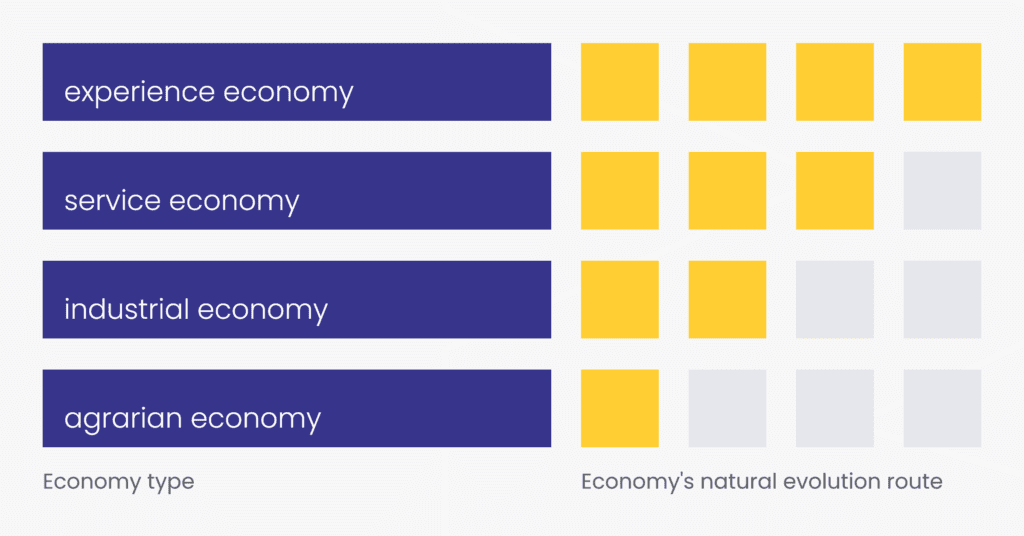
Employee experience: When money is no longer a motivator
How to retain employees when money is no longer the primary motivator? This crucial question resonates among many employers in the sphere of contemporary business. What measures can be taken to ensure that employees not only stay in the company but also thrive within the organization? How to discourage turnover while instilling a sense of identity and shared values, fostering greater enthusiasm and productivity? Money is no longer the paramount factor; now, it’s all about employee experience. The concept of the experience economy has become a powerful force, representing a paradigm shift in how organizations engage in relationships with their employees. Prioritizing transactional efficiency becomes crucial, emphasizing tactical relationships with employees and transactional interactions.

The essence of the experience economy
The experience economy, as delineated by Pine and Gilmore in their groundbreaking work, stands as the fourth economic force alongside the agricultural, industrial, and service economies. In this paradigm, time and emotions function as the currency, possessing substantial economic value for consumers. The intensity and durability of these emotions and experiences directly influence consumer decisions and economic outcomes. Moreover, within an era characterized by heightened consumer empowerment and information accessibility, businesses face the challenge of crafting unique and authentic experiences that not only meet but surpass customer expectations.

Exploring the interplay: customer experience vs employee experience
Customer experience (CX) and employee experience (EX) are two sides of the same coin in the contemporary business landscape. Just as companies prioritize delivering exceptional experiences to their customers, they must also focus on cultivating positive experiences for their employees. The concept of CX centers on the entirety of customer interactions and emotions associated with a brand or company, spanning from initial engagement to post-purchase interactions. Likewise, EX encompasses the collective impact of all interactions and events that an employee undergoes within an organization, from recruitment to daily work experiences and beyond.
Traditionally, businesses concentrated on enhancing CX to bolster customer satisfaction and loyalty, leveraging strategies such as user-centered design principles to meet evolving expectations. However, recent global events, notably the challenges posed by the pandemic, have prompted a reevaluation of priorities. This shift has seen a broader recognition of the importance of EX, as organizations acknowledge the critical role of their employees in delivering exceptional customer experiences.
Communication and HR departments, historically instrumental in fostering EX through talent retention efforts, are now steering initiatives with a more profound focus on employee well-being and support. This shift towards a more human-centric approach translates into increased attention to mental health, flexible work arrangements, and a greater emphasis on empathy and understanding in the workplace.
In essence, the parallel between CX and EX underscores the interconnectedness of customer and employee satisfaction. By prioritizing both, companies can create a virtuous cycle wherein satisfied employees contribute to enhanced customer experiences, ultimately driving business success in the experience economy.

Decoding employee experience concepts
Employee experience is succinctly defined as the robust connection between all elements crucial to a business, unfolding throughout an employee’s tenure and influenced by key factors such as Human, Development, Remuneration, Work Environment, and Organizational Culture.
Jacob Morgan’s Pyramid of Need concept, outlined in ‘The Employee Experience Advantage,’ establishes a foundational ‘Reason for Being’ at the core, shaping a positive employee experience and distinctive brand identity. The subsequent tiers encompass the three main environments—Physical Workplace, Culture, and Technology—while the next level involves 17 variables meeting diverse employee needs, from flexible working hours to development opportunities. At the pyramid’s peak, the focus is on ‘Moments that Matter,’ intentionally crafting significant events like the first day and expressions of appreciation.
Alternatively, the Employee Digital Journey concept views the employee experience as a holistic digital journey from job application to departure, including tailored touchpoints like recruitment, onboarding, development, retention, and exit. This approach ensures a personalized digital experience throughout the employee’s professional journey.

EX strategy – to have or not to have?
Developing a successful strategy to cultivate positive employee experiences requires a nuanced understanding of their ever-changing needs, which mirror the dynamic external environment.
Employers consistently invest resources, funds, and even create dedicated roles in their pursuit of influencing employee experience, and this isn’t without reason. Positive employee experiences lead to increased satisfaction, efficiency, and higher rates of staff retention. Essentially, it empowers employees to carry out their responsibilities with greater proficiency, infusing their work with a deeper sense of purpose aligned with their values and goals. Fulfilled employees not only excel in their roles, positively impacting the quality of products or services offered by the organization but also enhancing customer experience and satisfaction.

Navigating the complexities of building positive employee experiences requires a comprehensive approach. This includes addressing various aspects such as organizational purpose, mission and vision, the entire spectrum of learning and development, the Employee Value Proposition (EVP), working methodologies (with a focus on collaboration and innovation principles), and the seamless integration of digital experiences.
In a world where money is no longer the primary motivating factor for employees, focusing on the Employee Experience is the most promising competitive advantage that organizations can create.
Jacob Morgan, the author of The Employee Experience Advantage
The power of ROX (Return on Experience)
Measuring the expenditure on Employee Experience (EX) and its return on investment can be achieved through the holistic lens of Return on Experience (ROX). This innovative approach transcends traditional metrics by comprehensively evaluating and enhancing the value derived from investments in Customer Experience (CX), Employee Experience (EX), and Leader Experience (LX). By reimagining and restructuring the interplay among these three dimensions, ROX becomes a powerful and scalable method to shape the future trajectory of a business.
ROX converges experience data with operational Key Performance Indicators (KPIs) and outcomes, utilizing simulation and predictive analytics to finely optimize strategic decision-making. It not only gauges the impact these experiences have on each other but also their collective influence on the overall brand. In essence, ROX emerges as one of the most effective methodologies to drive sustainable business growth, aligning experiential insights with operational effectiveness.

In the evolving business landscape, the experience economy signifies a transformative shift in how organizations engage with employees. Emphasizing transactional efficiency and tactical relationships, this paradigm views time and emotions as valuable currencies influencing consumer decisions. This extends to customer experience (CX) and employee experience (EX), emphasizing the need for authentic, surpassing experiences. The holistic evaluation of Return on Experience (ROX) emerges as a pivotal method for maximizing investments in CX, EX, and Leader Experience (LX). This concise overview highlights the interconnectedness of positive experiences for customers and employees, paving the way for enduring success in the dynamic business environment.
